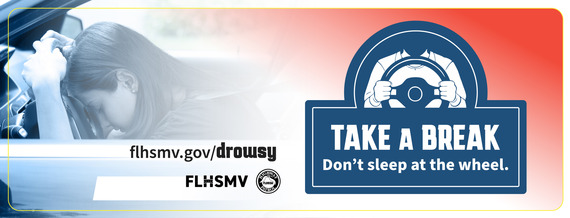
TALLAHASSEE, FLA.– Today, the Florida Department of Highway Safety and Motor Vehicles (FLHSMV) and its division of the Florida Highway Patrol (FHP), are proud to launch our annual Drowsy Driving Prevention Campaign. This campaign, spanning a month, is a vital initiative. The first week, September 1-7, is dedicated to the memory of Ronshay Dugans, a tragic victim of drowsy driving in 2008.
Many of us lead busy lives, juggling family commitments, work responsibilities, and urgent tasks. Amid these demands, it’s easy to overlook our body’s signals. But when we take the wheel, it is our personal responsibility to ensure that we are prepared.
Throughout September, FLHSMV will focus on educating drivers to recognize the signs of exhaustion, how to prevent drowsiness when planning to be behind the wheel, and what to do if they are tired or displaying signs of fatigue while driving. Drowsy driving is a matter of public safety with potentially severe consequences that cannot be ignored. The good news is that drowsy driving is preventable. With the proper knowledge and actions, we can make our roads safer.
“Driving without adequate rest is dangerous. Drowsy driving is completely preventable and should be avoided at all costs. Anyone about to take the wheel should be fully alert, responsive, and ready for the drive,” said Executive Director Dave Kerner. “Drivers must weigh the risks and consequences of embarking on a journey without sufficient sleep. Such a decision could have a profound impact on their lives and the lives of others on the road.”
“Motorists should consider that Drowsy Driving is similar to Impaired Driving and poses a danger to everyone on the road,” said FHP Colonel Gary Howze II. “When tired, making safe and responsible choices such as switching drivers, stopping at rest areas, or delaying travel until everyone is rested is important. Each of these choices is better than setting yourself and others up for a higher risk of being involved in a crash with injury or loss of life. It’s your responsibility.”
In an article published by the National Highway Safety Administration (NHTSA), they acknowledge, “Tackling these issues (drowsy driving) can be difficult when our lifestyle does not align with avoiding drowsy driving. In a 24/7 society, with an emphasis on work, longer commutes, and exponential advancement of technology, many people do not get the sleep they need.”
The National Sleep Foundation advises in a 2023 report, “Drowsy driving is a significant public health concern in the United States. Estimates suggest motor vehicle crashes related to drowsy driving account for roughly 20% of all crashes. Data from the AAA Foundation indicate that sleepiness is implicated in 21% of all motor vehicle crashes resulting in death and 13% of motor vehicle crashes resulting in hospitalizations—totaling over 300,000 police-reported crashes, over 100,000 injuries, and as many as 6,400 deaths in the United States each year.”
In a position statement, published in 2023, the National Sleep Foundation stated, “Drowsy driving is impaired driving. It accounts for an estimated 1 in 5 fatal motor vehicle crashes on US roads, which demands everyone take responsibility to help prevent it as a form of impaired driving.”
Data from the AAA Foundation for Traffic Safety report published in March 2024 indicates that the number of drowsy driving crashes and fatalities increases every year. It also notes that it is underreported.
Together, these studies and reports make the crisis real. Drowsy driving is a dangerous potential within every Florida community. Everyone must know how to identify the signs of exhaustion or when someone is too tired to get behind the wheel.
“At the Florida Department of Transportation, we are deeply committed to ensuring the safety of every person on our roads,” said Florida Department of Transportation Secretary Jared W. Perdue, P.E. “We encourage all drivers to recognize the signs of drowsiness and prioritize rest before getting behind the wheel. Together, we can eliminate traffic fatalities and serious injuries across Florida.”
“Drowsy driving accounts for about 100,000 crashes each year,” said FSA President and Charlotte County Sheriff Bill Prummell. “Death and serious injuries are preventable if you take precautions before you get behind the wheel. Get adequate sleep and avoid alcohol as well as medications that may make you sleepy. Pull over at the first sign that you’re becoming drowsy to ensure you, any passengers and others on our roadways arrive alive.”
“Sometimes life’s demands may lead drivers to believe they must drive even when drowsy — whether due to work pressures, long trips, or other obligations, but the Florida Police Chiefs Association urges everyone to reconsider this choice,” said FPCA president Chief Charles Vazquez, Tampa International Airport Police Department. “Rest is not just a personal benefit but a critical component of road and public safety. By choosing to drive alert, you are actively protecting yourself and others on the road. Let’s prioritize safety together, recognizing that a well-rested driver is the safest driver.”
“Commercial Motor Vehicle (CMV) drivers have very explicit federal Hours of Service requirements for rest,” said Alix Miller, President and CEO of the Florida Trucking Association. “If you’re a truck driver, and feeling drowsy, it doesn’t matter if you’re in the beginning, middle, or end of your drive. You need to pull over and rest to make sure everyone on our roads gets home safely.”
According to research from the AAA Foundation for Traffic Safety, drivers may underestimate their drowsiness, said Michele Harris, Florida Public Affairs Director, AAA – The Auto Club Group. “That is why it is important to take steps to stay alert because even when drivers rated their level of drowsiness as low, 75% of them were, in fact, moderately or severely drowsy.”
What can we do?
Drowsy driving is 100% preventable. If awareness is raised and everyone is familiar with the signs of exhaustion BEFORE a driver gets behind the wheel, the risk of driving drowsy will be removed.
Recognize the signs of Drowsy Driving:
- Yawning or frequent blinking.
- Difficulty remembering the past few miles driven.
- Missing your exit.
- Drifting from your lane.
- Hitting a rumble strip on the side of the road.
- Nodding off or micro sleeping.
- Following other cars too closely.
- Difficulty maintaining proper speed.
If you notice yourself feeling drowsy, having difficulty focusing, yawning frequently, or drifting out of your lane, these are warning signs that indicate it’s time to pull over and take a break or consider changing drivers. It’s important to recognize these signs and not rely on ineffective methods such as turning up the radio or opening the window to keep yourself alert and safe on the road.
Who is most at risk to Drive Drowsy?
- Drivers who do not get enough sleep.
- Shift workers (work the night shift or long shifts).
- Teenagers who have less driving experience and high rates of sleep insufficiency.
- Drivers who use medications that make them tired.
- Those who have consumed alcohol.
- Commercial drivers, bus drivers, or those who drive a significant number of miles at night.
- Drivers on the road between midnight and 6 a.m. or in the later afternoon.
- People with severe sleep problems, including insomnia or other sleep disorders.
To avoid the risk of drowsy driving, you should:
- Get enough sleep before you get behind the wheel; it is the best way to ensure you can maintain alertness while driving.
- Read the warning label on your medications, and do not drive after taking medications that cause drowsiness.
- On long trips, take a break every 100 miles or two hours. Allow plenty of time to get to your destination.
- Use the “buddy system” so you can change drivers when needed.
- Avoid driving at times when you would usually be asleep. If you have difficulty focusing, frequent blinking, or heavy eyelids, pull over in a safe place to rest before continuing to drive.
- The Florida Department of Transportation maintains multiple rest areas, service plazas, truck comfort stations, and welcome centers throughout Florida. There are great places to stop and take a break. For more information, visit their webpage here.
Be wary of “tricks” to stay awake: Some people try rolling down their windows or turning up the air conditioning or radio, but this can draw your attention away from the road. Instead of using these tricks, it is better to stop and let your body get the rest it needs.
Visit FLHSMV’s website, flhsmv.gov/drowsy, for more information and shareable resources to help spread the word about drowsy driving prevention.

###
The Florida Department of Highway Safety and Motor Vehicles (FLHSMV) provides highway safety and security through excellence in service, education, and enforcement. Learn more on our website.
The Florida Highway Patrol strives to achieve core values of courtesy, service, and protection. It is FHP’s job to help ensure the safety and welfare of millions of Florida’s residents and visitors every day.
To learn more about FHP or how to become one of Florida’s Finest, visit BeATrooper.com.
